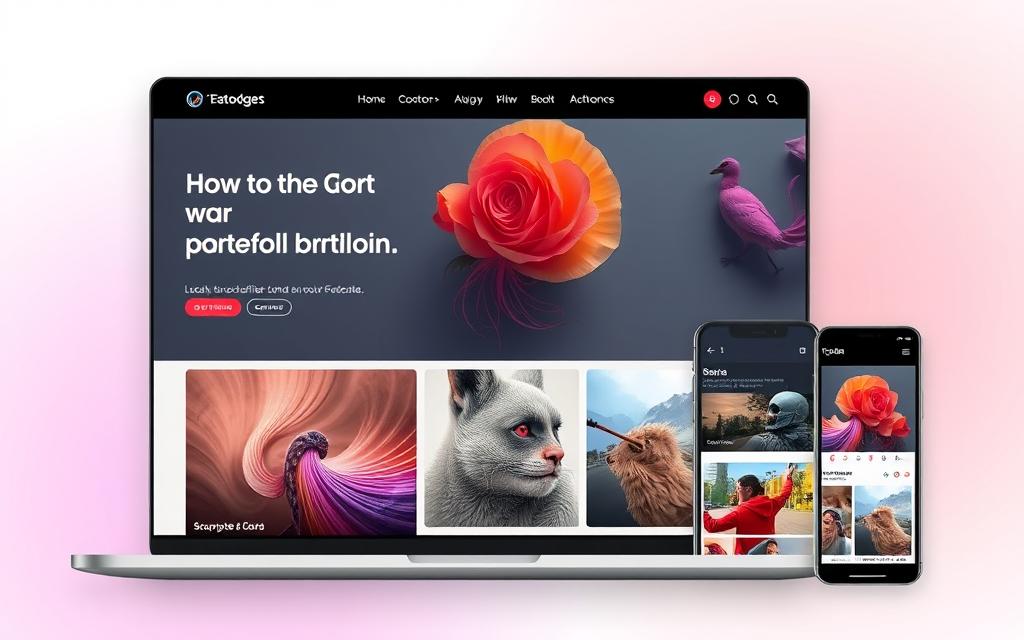A user-friendly portfolio website serves as your digital shop window, showcasing your skills and enticing potential clients or employers. With the average viewer spending just 10-15 seconds on a portfolio, it’s crucial to prioritize concise and visually appealing portfolio website design. First impressions matter, and a clever layout can significantly enhance how your work is perceived in a crowded market. Remember, applying the ‘less is more’ rule can lead to better engagement; focusing on quality rather than quantity in your showcased projects makes a notable difference. It’s also important to emphasize user experience through easy navigation and relevant content, creating a pathway for connections that can lead to exciting opportunities.
Define Your Goals for a User-Friendly Portfolio Website
Creating a user-friendly portfolio website requires defining clear goals that will guide your design and content choices. Knowing your objectives from the outset will enhance the overall user interaction and effectiveness of your creative website. Start by understanding who your visitors will be, what they seek, and how your website can meet those needs.
Identify Your Target Audience
Defining your target audience is vital in shaping a user-friendly portfolio. Recognizing whether your visitors are potential employers, clients, or collaborators will allow you to tailor your content and design specifically for them. This awareness aligns with online portfolio tips that focus on user-centric design, ensuring your website resonates with the correct demographic.
Clarify Your Unique Value Proposition
Your unique value proposition distinguishes you from the competition and helps you present yourself effectively. Clearly articulate what makes you stand out and how your skills can fulfill your audience’s needs. This clarity can significantly enhance the perceived value of your creative website, encouraging users to engage further.
Determine User Interaction Goals
Establishing your user interaction goals is crucial in determining how visitors will engage with your website. Decide whether you want users to contact you, subscribe to a newsletter, or follow you on social media. These intentions will guide your design choices, ensuring that your portfolio not only showcases your work but also fosters meaningful connections.
Utilize Simple Layout and Design Principles
Creating a portfolio website involves a careful balance of aesthetics and functionality. Integrating simple layout and design principles plays a crucial role in enhancing user experience and ensuring your content is easily digestible. Start by utilizing whitespace, which is essential for creating breathable designs that guide the viewer’s attention toward key content.
Importance of Whitespace for Readability
Whitespace significantly improves readability and comprehension on your website. By allowing your content space to breathe, you create an organized layout that helps users focus on what matters most. This approach not only emphasizes important elements but also contributes to a clean design that promotes a sense of professionalism. As users engage with your work, well-structured content can improve information retention by 40%, allowing them to absorb your message effectively.
Responsive Design for All Devices
In today’s digital landscape, responsive design is non-negotiable. An optimum user experience is essential as more visitors browse portfolios on mobile devices. A website that adapts seamlessly across various screen sizes, from desktops to tablets and smartphones, accommodates diverse user preferences. Websites that achieve responsive design improve engagement rates, meeting user expectations and keeping them connected to your work.
Color Choices that Enhance User Experience
The impact of color choices on user experience cannot be overstated. Thoughtful selection of colors evokes emotions and cultivates a welcoming atmosphere. Harmonious palettes resonate with your personal style while reinforcing your brand identity. Striking the right balance between vibrant hues and subtle tones promotes engagement, as visually appealing designs draw viewers into your content. Remember, a well-executed color scheme can increase user attention and create a lasting impression.
User-Friendly Portfolio Websites: Showcase Your Best Work
Creating a standout portfolio website involves careful curation of high-quality content that truly reflects your skills and creative prowess. To effectively showcase your best work, concentrate on selecting projects that highlight your expertise in digital design. Clients and employers often seek specific skills, so presenting exemplary projects can significantly impact their perception of your capabilities.
Curate High-Quality Content
Focus on quality over quantity when assembling your portfolio. Choose only the projects that demonstrate your strongest skills and creativity. Including detailed descriptions, relevant visuals, and your artistic process will enhance the presentation. This not only helps potential clients gauge your abilities but also emphasizes your unique approach to challenges within the realm of digital design.
Provide Context for Each Project
Providing context is essential for every project you showcase. Share the challenges you faced, your problem-solving strategies, and the results achieved. This transparency enriches your portfolio, allowing visitors to understand not just the final products but also your thought processes and methodologies. Such insights forge a deeper connection with your audience, ensuring that your work remains memorable and impactful.
Optimize Website Performance and Navigation
Creating a user-friendly portfolio website requires a focus on both performance and navigation. Achieving quick load times enhances user satisfaction, encouraging visitors to engage with your content rather than leaving in frustration. Directly addressing factors that contribute to slow loading pages can significantly affect your conversion rates and overall site success.
Ensure Fast Loading Times
Fast loading times are essential for website optimization. Users expect web pages to load in two seconds or less; exceeding this expectation can enhance user experience and retention. Techniques such as compressing images can reduce file sizes by as much as 80%, ensuring that your visuals maintain quality while increasing loading speed. Additionally, consider implementing browser caching and content delivery networks (CDNs) to further decrease load times and provide a seamless experience for returning visitors.
Simplify Site Navigation for Better User Experience
Intuitive site navigation plays a critical role in improving user engagement. A clear and concise menu structure allows users to find relevant information swiftly, minimizing friction during their journey. Websites with effective navigation can see conversion rates boosted by over 20%. To create a user-friendly atmosphere, limit the number of menu items and maintain consistency across pages. This leads to a streamlined experience and encourages visitors to explore more of your portfolio.
Incorporate User Feedback for Continuous Improvement
User feedback is invaluable when optimizing your portfolio site. Utilizing methods like surveys or analytics provides insights into user behavior and can highlight areas for enhancement. Engaging with visitors’ opinions can lead to better understanding and personalization of the user experience. Implementing these changes based on user feedback can lead to increased satisfaction and loyalty, ultimately reinforcing trust and encouraging repeat visits.
| Optimization Technique | Benefit |
|---|---|
| Image Compression | Reduces page weight by up to 80% |
| Browser Caching | Decreases load time for returning users by 30-50% |
| CDN Usage | Enhances loading speed globally by serving content from the nearest server |
| Intuitive Navigation | Boosts conversion rates by over 20% |
| Incorporating User Feedback | Improves user satisfaction and loyalty |
Conclusion
Creating user-friendly portfolio websites requires a thoughtful balance of design and content. The rising standard across numerous industries emphasizes the need for an effective online portfolio that not only showcases your best work but also meets the specific needs of your target audience. With over 70% of hiring managers in creative fields skipping résumés to evaluate portfolios directly, it’s essential to create engaging content that captivates potential employers.
Whether you opt for a structured format—preferred by 55% of professionals due to its extensive navigational capabilities—or a simple one-pager, ensuring fast loading times and intuitive navigation can greatly enhance user experience. Regularly updating your portfolio not only signals your active engagement but also keeps your portfolio relevant and aligned with current trends in digital design and user expectations.
As you refine your effective online portfolio, remember that authenticity is key. Incorporating testimonials and showcasing measurable outcomes can enhance your credibility, ultimately attracting the right opportunities in your creative career. Keep evolving and learning from user interactions to maintain a portfolio that not only reflects your unique style but also engages visitors effectively.










